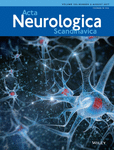Elevated levels of ferritin in the cerebrospinal fluid of amyotrophic lateral sclerosis patients
Funding information
The study was supported by the Tianjin Health Bureau 2015KZ022.
Abstract
Objectives
The aim of the study was to detect changes in the levels of ferritin heavy chain (FHC), ferritin light chain (FLC), and transferrin in the cerebrospinal fluid (CSF) and serum of amyotrophic lateral sclerosis (ALS) patients and to analyze the correlations between the levels of these proteins and various clinical parameters.
Methods
Cerebrospinal fluid and serum samples were obtained from 54 ALS patients and 46 non-inflammatory neurological disease control (non-INDC) patients. CSF and serum FHC, FLC, and transferring levels were measured via the enzyme-linked immunosorbent method using a commercial ELISA kit, and the times from onset (durations), ALS functional rating scale—revised (ALSFRS-r) scores, and disease progression rates (DPRs) were analyzed by registered neurologists. Statistical analysis was performed via Prism software.
Results
Compared with controls, ALS patients exhibited significantly increased FHC and FLC levels in CSF, which were positively correlated with DPR and negatively correlated with duration. Serum transferrin levels were significantly increased in ALS patients but were not correlated with disease progression. FHC and FLC in CSF rapidly increased as the disease worsened.
Conclusions
This study demonstrated that the clinical measurement of FHC and FLC in CSF may be beneficial for disease differentiation and evaluating progression in patients with ALS. Compared with levels in serum, the levels of FHC and FLC in CSF might be more reliable for diagnosing and assessing the progression of ALS.




